Respiration And Excretion Formative Worksheet
Question 1. Cellular respiration is a process in which food is broken down in a cell and converted into energy. Respiration is an example of
- A catabolic process
- Transportation of ions
- Anabolic process
- Excretion of ions
Answer: 1. A catabolic process
Question 2. Which of the following statements about cellular respiration is correct?
- Oxygen is released during cellular respiration.
- Cellular respiration leads to the formation of starch.
- Cellular respiration leads to the formation of glucose.
- Carbon dioxide is released during cellular respiration.
Answer: 4. Carbon dioxide is released during cellular respiration.
Question 3. The given equation represents respiration. Sugar + O2 → CO2 + X + Energy In the given equation, X represents
- Water
- Lipids
- Proteins
- Vitamins
Answer: 1. Water
“respiration in organisms question answer “
Question 4. During respiration, _____1_____ and _____2_____ are utilized to produce energy, CO2, and H2O. Which alternative completes the given statement?
- 1- glucose 2- oxygen
- 1- oxygen 2- carbon monoxide
- 1- carbon monoxide 2- sulfur dioxide
- 1- sulfur dioxide 2-glucose
Answer: 1. 1- glucose 2- oxygen
NEET Biology Class 7 Respiration and Excretion MCQs
Question 5. Aerobic respiration is a type of cellular respiration that takes place in the presence of oxygen. Which of the following substances is not produced during aerobic respiration?
- Water
- Energy
- Carbon dioxide
- Lactic acid
Answer: 4. Lactic acid
Question 6. Which of the following statements regarding the process of anaerobic respiration is correct?
- It involves the breakdown of alcohol.
- It occurs in the presence of oxygen.
- It involves the production of water.
- It releases carbon dioxide.
Answer: 4. It releases carbon dioxide.
Question 7. Yeast is commercially used for the preparation of alcohol and ____1____ by the process of _____2______. The information in which alternative completes the given statement?
- 1-wine 2- fermentation
- 1-antibiotics 2-fermentation
- 1-wine 2-aerobic respiration
- 1-antibiotics 2-aerobic respiration
Answer: 1. 1-wine 2- fermentation
Respiration and Excretion NEET MCQs with Answers
Question 8. The given equation illustrates the breakdown of glucose in a yeast cell. Glucose Carbon dioxide + Energy The information in which alternative completes the given equation?
- 1- Absence of oxygen 2- Alcohol
- 1- Absence of oxygen 2-Water
- 1- Presence of oxygen 2-Alcohol
- 1- Presence of oxygen 2-Water
Answer: 1.1- Absence of oxygen 2- Alcohol
“respiration in organisms class 7 questions and answers “
Question 9. The alternatives in the given table can be correctly matched as Column 1 and Column 2
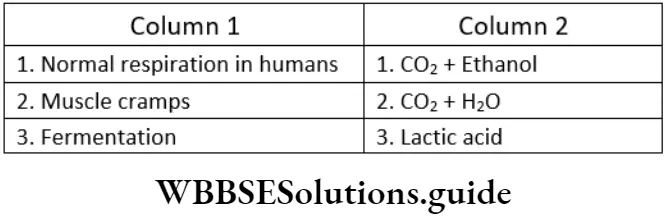
- 1 → 2, 2 → 3, 3 →1
- 1 → 3, 2 → 2, 3→ 1
- 1 → 1, 2→ 2, 3→ 3
- 1 →2, 2 →3, 3 →2
Answer: 1. 1 →2, 2 → 3, 3 → 1
Question 10. Which of the following statements is correct regarding respiration in plants?
- Respiration stops when photosynthesis occurs.
- Roots are underground, hence do not respire.
- Respiration in plants occurs by diffusion.
- Germinating seeds do not respire.
Answer: 3. Respiration in plants occurs by diffusion.
NEET Biology Respiration and Excretion Important MCQs
Question 11. The ____1____ present on the ___ 2___ of plants help in the exchange of gases. The information in which alternative completes the given statement?
- 1-stomata 2-leaves
- 1-stomata 2-roots
- 1-xylem 2-leaves
- 1-xylem 2-roots
Answer: 1. 1-stomata 2-leaves
Question 12. Breathing is the process of intake of oxygen-rich air and giving out carbon dioxide-rich air. The process of taking in oxygen-rich air is known as
- Exhalation
- Inhalation
- Ingestion
- Egestion
Answer: 2. Inhalation
Question 14. The process of releasing carbon dioxide-rich air from the body is known as
- Exhalation
- Inhalation
- Ingestion
- Egestion
Answer: 1. Exhalation
Question 15. During a process X, the ribs of a person are moving out and its diaphragm is moving down towards the abdomen. According to the given information, process X
- Can only be inhalation
- Can only be exhalation
- Signifies holding of breath
- This signifies breathing on a whole
Answer: 2. Can only be an exhalation
Question 14. During the process of exhalation, ribs move ____1_____, while the diaphragm moves ____2_____. The information in which alternative completes the given statement?
- 1-outward 2-downward
- 1-downward 2-upward
- 1-upward 2-inward
- 1-inward 2-outward
Answer: 1. 1-outward 2-downward
Best Multiple Choice Questions for Class 7 Biology Respiration and Excretion
Question 17. The given table illustrates the speed of running of a person at different times. Minute Speed of running (m/s)
“respiration in organisms class 7 questions and answers “
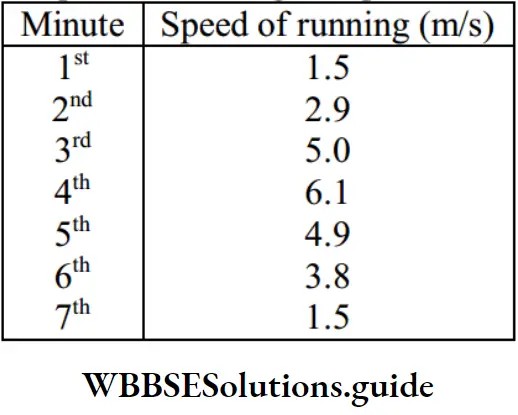
At 4th minute,
- Only the rate of inhalation increases
- Only the rate of inhalation decreases
- The rates of both inhalation and exhalation increase
- The rates of both inhalation and exhalation decrease
Question 18. The given illustration represents the human excretory system. In the given illustration, the structure labeled X represents
- Kidney
- Ureter
- Urinary bladder
- Urethra
Answer: 3. Urinary bladder
Question 19. What is the primary excretory product of humans?
- Ammonia
- Urea
- Glucose
- Starch
Answer: 2. Urea
Question 20. What is the primary function of the ureter?
- Storing urine
- Producing urine
- Passing urine out of the body
- Transporting urine from the kidneys to the urinary bladder
Answer: 4. Transporting urine from the kidneys to the urinary bladder
Question 21. Kidneys filter waste material from the blood and remove them from the body. Blood is supplied to the kidneys by the circulatory system. Blood is supplied to the kidneys by the
- Renal vein
- Renal artery
- Pulmonary vein
- Pulmonary artery
Answer: 2. Renal artery
“respiration in organisms class 7 questions and answers “
Question 22. Urea, uric acid, and ammonia are the chief excretory products of a large number of animals. Which of the following animals excretes wastes in the form of urea?
- Sparrow
- Humans
- Lizard
- Snake
Answer: 2. Humans
Question 23. The given diagram represents the structure of the human excretory system Which of following functions is not performed by the kidneys?
- Formation of urine
- Oxygenation of blood
- Reabsorption of water
- Maintenance of salt balance
Answer: 2. Oxygenation of blood
Respiration and Excretion Class 7 NEET Objective Questions
Question 24. On average, a person excretes about 1.2 L of urine in 24 hours. What would be the approximate amount of urea excreted by the person at the same time?
- 10 gm
- 30 gm
- 60 gm
- 80 gm
Answer: 2. 30 gm
Question 25. Dialysis is the artificial process of regulation of fluids and mineral concentration in the human body. Which organ is replaced through dialysis?
- Lung
- Heart
- Kidney
- Liver
Answer: 3. Kidney
Question 26. The alternatives in the given table can be correctly matched as Column 1 Column 2
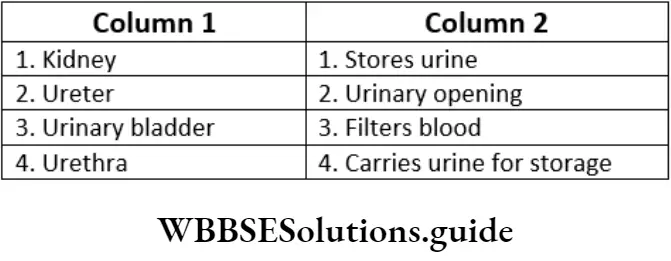
- 1 →1, 2 → 2, 3 →3, 4 → 4
- 1→ 1 2 →2, 3 →4, 4 → 3
- 1 →3, 2→ 4, 3 →1, 4→2
- 1 → 3, 2 → 2, 3 → 4, 4 → 1
Answer: 3. 1 → 3, 2→ 4, 3 → 1, 4→ 2
NEET Biology Class 7 Chapter 7 MCQs with Solutions
Question 27. Excretory system performs the functions of formation, storage, and removal of urine. What is the primary function of the urethra?
- Storing urine
- Producing urine
- Passing urine out of the body
- Transporting urine from the kidneys to the urinary bladder
Answer: 3. Passing urine out of the body
Question 28. The basic functional unit of the kidney regulates the concentration of water and soluble substances in the body. It functions by filtering blood under pressure. It then reabsorbs the necessary fluids and excretes the waste products. The above function is performed by
- Renal artery
- Nephron
- Aorta
- Renal vein
Answer: 2. Nephron
“respiration in organisms class 7 questions and answers “
Question 29. Which of the following functions is not performed by kidneys?
- Removal of body toxins
- Supplying oxygen to the body
- Maintaining body salt balance
- Filtering of wastes from the blood
Answer: 4. Filtering of wastes from the blood
Question 30. Which of the following functions is not performed by kidneys?
- Removal of body toxins
- Supplying oxygen to the body
- Maintaining body salt balance
- Filtering of wastes from the blood
Answer: 4. Filtering of wastes from the blood
Question 31. Urine is stored in the urinary bladder before it is excreted. The urinary bladder can expand and contract depending on the amount of urine present in it. Which system allows the expansion and contraction of the urinary bladder?
- Vascular system
- Excretory system
- Nervous system
- Muscular system
Answer: 4. Muscular system
Question 32. Urine is a waste product formed inside the kidneys after the filtration of blood. Which of the following substances is not reabsorbed in the nephron from the urine formed inside it?
- Salts
- Glucose
- Uric acid
- Amino acids
Answer: 3. Uric acid
Question 33. _____1_____ and _____2_____ are examples of animals that excrete nitrogenous wastes in the form of uric acid. The information in which alternative completes the given statement?
- 1- Birds 2- lizards
- 1- Lizards 2-fishes
- 1-fishes 2-humans
- 1-humans 2-birds
Answer: 1. 1- Birds 2- lizards
Question 34. Animals inhabit many environments. Aquatic animals have specialized excretory organs well adapted to help them survive in water. Which of the following characteristics is true for fish?
- Excretion of concentrated urine
- Excretion of dilute urine
- Absence of excretory organs
- Absence of respiratory organs
Answer: 2. Excretion of dilute urine
Respiration And Excretion Conceptive Worksheet
Question 1. Cellular respiration is the process wherein
- Food is synthesized in the cell to provide energy
- Food is broken down in the cell to release energy
- Carbon dioxide is exhaled
- Oxygen is inhaled
Answer: 3. Food is synthesized in the cell to provide energy
“respiration in organisms class 7 questions and answers “
Question 2. Cellular respiration is the process by which cells generate energy molecules. What is not produced during cellular respiration?
- Carbon dioxide
- Water molecules
- Glucose molecules
- ATP molecules
Answer: 1. Carbon dioxide
Question 3. The given equation represents cellular respiration. Sugar + X → CO2 + Water+ Energy In the given equation, X represents
- Oxygen
- Sunlight
- Nitrous oxide
- Sulfur dioxide
Answer: 4. Sulfur dioxide
Question 4. Cellular respiration takes place inside the cells of all living organisms. Which of the following events does not occur during cellular respiration?
- Formation of carbon dioxide
- Breakdown of glucose
- Release of energy
- Release of oxygen
Answer: 3. Release of energy
NEET Study Material for Respiration and Excretion with MCQs
Question 5. Cellular respiration is of two types- aerobic and anaerobic. Which of the following statements regarding aerobic respiration is incorrect?
- It involves the breakdown of glucose.
- It does not involve the production of alcohol.
- It does not require oxygen to carry out the reaction.
- It releases carbon dioxide as a by-product of the reaction.
Answer: 2. It does not involve the production of alcohol.
Question 6. Anaerobes are organisms that respire through anaerobic respiration. Which of the following organisms is an anaerobe?
- Fish
- Yeast
- Cockroach
- Earthworm
Answer: 2. Yeast
Question 7. Yeast is used in the commercial production of 1 and 2. The information in Which alternative completes the given statement?
- 1- vinegar 2-alcohol
- 1-alcohol 2-oil
- 1-oil 2-glucose
- 1-glucose 2-vinegar
Answer: 1. 1- vinegar 2-alcohol
Question 8. During strenuous exercises, lactic acid is produced in our muscles because
- O2 supply < O2 demand
- O2 supply > O2 demand
- O2 supply is in accordance with O2 demand
- O2 supply is completely restricted in muscles
Answer: 3. O2 supply is in accordance with O2 demand
Ayush set up the given experiment to study the production of alcohol by yeast. He
added some
“respiration in organisms class 7 questions and answers “
Question 9. Yeast to a test tube (tube A) containing fruit juice. He covered the tube with a piece of cork and connected the test tube to another test tube (tube B) containing some lime water with a delivery tube. The whole setup was maintained airtight. After some time, he noticed that the lime water in tube B had turned milky. Which of the following gases was produced by yeast which is responsible for the given observation?
- Oxygen
- Nitrogen
- Carbon dioxide
- Carbon monoxide
Answer: 3. Carbon dioxide
Question 9. Which process uses carbon dioxide and produces oxygen as a waste product?
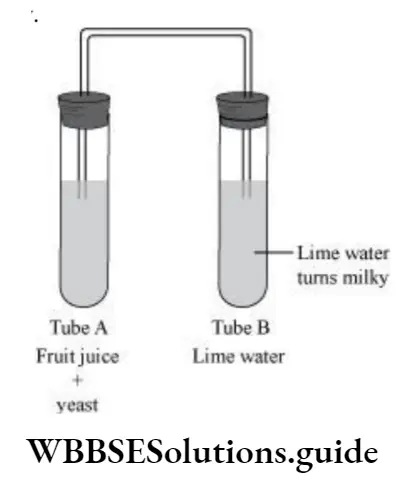
- Transpiration
- Respiration
- Photosynthesis
- Osmosis
Answer: 3. Photosynthesis
Respiration and Excretion Class 7 NCERT MCQs with Answer Key
Question 10. In plants, gaseous exchange occurs through
- Xylem
- phloem
- stomata
- chloroplast
Answer: 3. stomata
Question 11. Which of the following activities is a significant function of the nasal cavity?
- Cleaning the inhaled air
- Cleaning the exhaled air
- Initiating the process of inhalation
- Initiating the process of exhalation
“respiration in organisms class 7 questions and answers “
Answer: 1. Cleaning the inhaled air
Question 12. Which of the following events does not take place during inhalation?
- Upward and outward movement of ribs
- Downward movement of the diaphragm
- Decrease in the size of the chest cavity
- Movement of air into the lungs
Answer: 3. Decrease in the size of chest cavity
Question 13. Which illustration represents the process of inhalation?
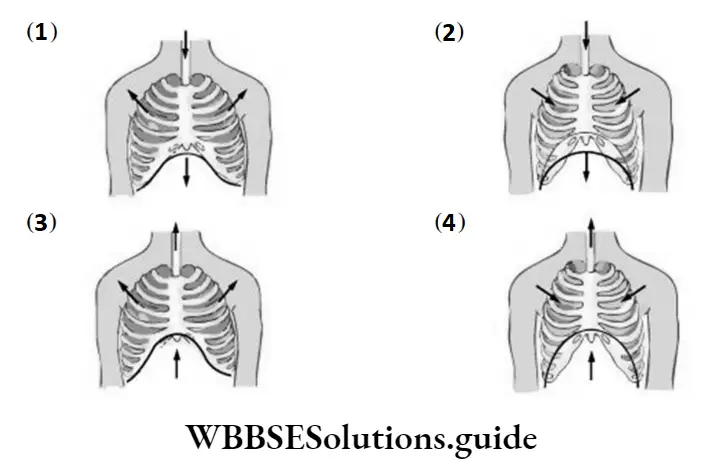
Answer: 1.
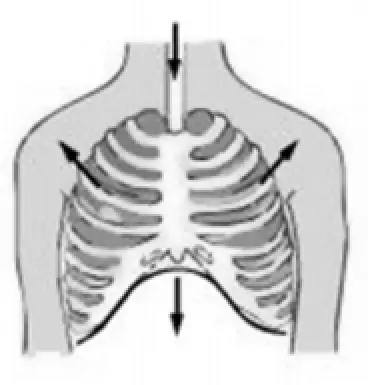
Question 14. Shalini took some freshly prepared lime water in a test tube and with the help of a plastic straw, blew some air into the test tube. Which statement correctly states the observation made in the given experiment?
- The lime water will turn milky indicating the presence of carbon dioxide
in exhaled air. - The lime water will turn milky indicating the presence of oxygen in
exhaled air. - The lime water will remain unchanged indicating the presence of carbon
dioxide in - exhaled air.
- The lime water will remain unchanged indicating the presence of oxygen in
exhaled air.
Answer: 1. The lime water will turn milky indicating the presence of carbon dioxide in exhaled air.
Question 15. The given illustration represents the human excretory system. In the given illustration, the structure labeled X represents
- Kidney
- Ureter
- Bladder
- Urethra
Answer: 2. Ureter
Question 16. Body cells produce a large number of waste products that enter the blood. These waste products need to be removed from the body for the proper functioning of cells. The organ that filters waste from blood is the
- Brain
- Heart
- Kidney
- Stomach
Answer: 3. Kidney
Question 17. Which of the following functions is not performed by kidneys?
- Removal of body toxins
- Supplying oxygen to the body
- Maintaining body salt balance
- Filtering of wastes from the blood
Answer: 4. Filtering of wastes from the blood
Question 18. The human excretory system is made up of kidneys, ureters, urinary bladder, and urethra. The structure that helps in the storage of urine is
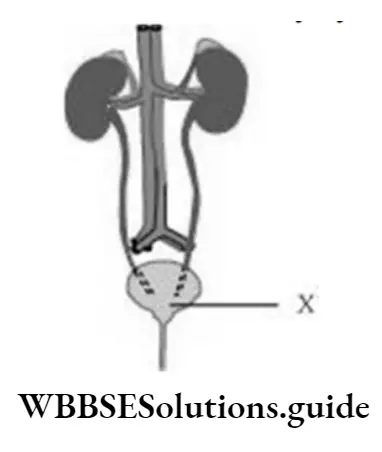
- Kidney
- Ureter
- Bladder
- Urethra
Answer: 3. Bladder
“respiration in organisms class 7 questions and answers “
Question 19. The kidneys are present in most vertebrate animals. The kidneys are important because they
- Remove body waste
- Digest food material
- Pump blood to all body parts
- Control different body movements
Answer: 1. Remove body waste
Question 20. Dialysis is the artificial process of regulation of fluids and mineral concentration in the human body. Which organ is replaced through dialysis?
- Lung
- Heart
- Kidney
- Liver
Answer: 3. Kidney
Question 21. The lungs end in alveoli, which are sac-like structures. The alveoli surface allows the exchange of respiratory gases between the blood cells and air. This helps in the purification of blood. Kidneys also play a role in this process. The basic unit of the kidney, where blood gets filtered, is called
- Ureter
- Neuron
- Urethra
- Nephron
Answer: 4. Nephron
Question 22. Excretory organs help the body in getting rid of waste products. Which of the following organs is not an excretory organ?
- Urethra
- Kidneys
- Lungs
- Heart
Answer: 4. Heart
Question 23. The human excretory system is made up of kidneys, ureters, urinary bladder, and urethra. The structure that helps in the formation of urine is
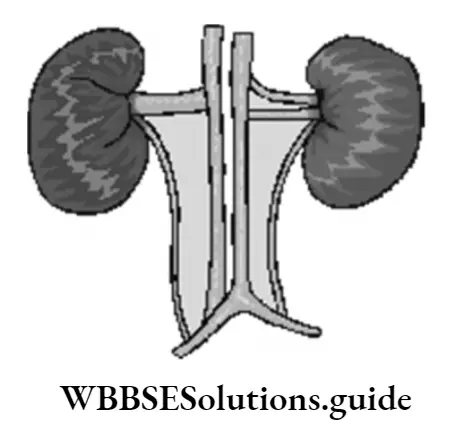
- Urinary bladder
- Urethra
- Ureter
- Kidney
Answer: 4. Kidney
Multiple Choice Questions on Human Respiratory and Excretory System for NEET
Question 24. The kidneys filter waste products present in the blood and excrete them. This waste is produced due to the chemical reactions occurring in the body. The basic unit of the kidney is known as the
- Ureter
- Urethra
- Neuron
- Nephron
Answer: 4. Nephron
“respiration in organisms class 7 questions and answers “
Question 25. Which of the following organs is not part of the excretory system?
- Kidneys
- Ovaries
- Bladder
- Ureter
Answer: 2. Ovaries
Question 26. Kidneys produce
- Urea
- Urine
- Carbon dioxide
- Nitrogen dioxide
Answer: 2. Urine
Question 27. The kidneys are part of the excretory system. They are present in the abdominal cavity. The kidneys perform the function of
- Removing metabolic waste from blood
- Removing carbon dioxide from blood
- Controlling body movement
- Aiding body movement
Answer: 1. Removing metabolic waste from blood
Question 28. Different animals excrete different types of nitrogenous wastes. Which of the following animals excretes ammonia?
- Fish
- Snake
- Lizard
- Cow
Answer: 1. Fish
Respiration And Excretion Summative Worksheet MCQs
Question 1. The process in which food is oxidized and energy is released is called
- Excretion
- Respiration
- Digestion
- Transpiration
Answer: 2. Respiration
Question 2. The end products of respiration are
- Only carbon dioxide
- Carbon dioxide and water
- Carbon dioxide, water, and energy
- Energy and carbon dioxide
Answer: 3. Carbon dioxide, water and energy
Question 3. The process in which only exchanges of gases take place is called
- Respiration
- Breathing
- Combustion
- Internal respiration
Answer: 1. Respiration
Question 4. In earthworms, the exchange of gases takes place through
- Water
- Gills
- Moist skin
- Spiracles
Answer: 3. Moist skin
Question 5. Alveoli are structures present in
- Lungs
- Bronchi
- Gills
- All the above
Answer: 1. Lungs
“respiration in organisms class 7 questions and answers “
Question 6. The pigment hemoglobin is present in
- White blood cells
- Red blood cells
- Platelets
- Lymph
Answer: 1. White blood cells
Question 7. Transpiration in plants occurs through
- Stomata
- Leaf tips
- Shoot apex
- Roots
Answer: 1. Stomata
Question 8. The process of removal of waste products from the body is called
- Transpiration
- Evaporation
- Excretion
- Respiration
Answer: 3. Excretion
Question 9. The structures, present in the kidney, which act as filters are
- Alveoli
- Nephrons
- Villi
- None of the above
Answer: 2. Nephrons
Question 10. The urinary bladder opens into
- Urethra
- Nephron
- Ureter
- Neuron
Answer: 3. Ureter
“respiration in organisms class 7 questions and answers “
Respiration And Excretion Fill In The Blanks
Question 1. During respiration, when energy is released, ______________ and ______________ are also produced.
Answer: Carbon dioxide and water
Question 2. The substance in red blood cells that joins with oxygen is called ______________.
Answer: Hemoglobin
Question 3. Anaerobic respiration is carried out by ______________
Answer: Yeast And Bacteria
Question 4. Skin helps in the excretion of water and ______________
Answer: Diffusion
Question 5. Excretion of wastes in unicellular organisms takes place by ______________
Answer: Excretion
Question 6. Getting rid of waste materials in living beings is called ______________
Answer: Urea and salt
Question 7. In humans, carbon dioxide is excreted through ______________
Answer: Lungs
Question 8. Kidneys are made up of a number of filters called ______________
Answer: Nephrons
Question 9. Kidneys are connected to the urinary bladder by long tubes called ______________
Answer: Ureter
Question 10. In insects, breathing occurs through openings called _____________
Answer: Spiracles
Question 11. Fish respire through structures called ______________
Answer: Gills
Question 12. Air sacs present in the lungs are called ______________
Answer: Alveoli
Question 13. The waste product of respiration is
Answer: Carbon dioxide And Water
Question 14. The process by which energy is produced for use in various functions of the body is called
Answer: Respiration
Respiration And Excretion Write True Or False
Question 1. In respiration, oxygen is required and carbon dioxide is given out.
Answer: True
Question 2. Diffusion of gases takes place through a small part of the root surface.
Answer: False
Question 3. In anaerobic respiration, a complete breakdown of food takes place.
Answer: False
Question 4. Earthworms absorb oxygen through moist skin.
Answer: True
